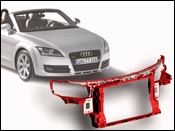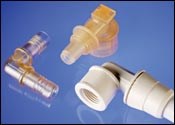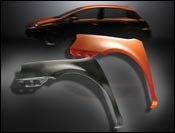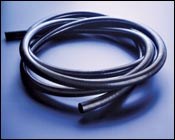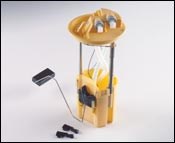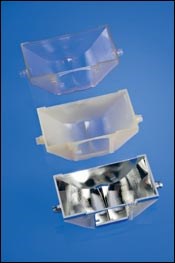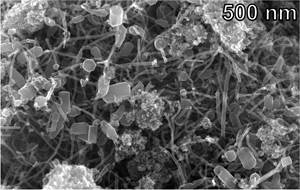What's New at the Show in MATERIALS
The major thrust in new materials at K is engineering thermoplastics for automotive, appliance, medical, and electrical/electronic parts.
The major thrust in new materials at K is engineering thermoplastics for automotive, appliance, medical, and electrical/electronic parts. There are plenty of new nylons, acetals, PBTs, and LCPs. There’s also news in TPEs, including crosslinkable TPUs with properties closer to thermoset rubber. Also look for a brand-new, high-heat amorphous polyphenylsulfone line. There will also be some news in PP and PE materials, and even in thermoset LSR.
Renewable bioplastics
A major thrust in R&D at DuPont is toward polymers made from chemical building blocks obtained from renewable resources—i.e., from biological/agricultural sources rather than fossil hydrocarbons. Its first success in this area is production of propanediol (PDO) starting with fermentation of cornstarch. A 100-million-lb/yr joint-venture plant was opened in June. This “Bio-PDO” has been used to make Sorona PTT polyester, which was first commercialized for textile and carpet fibers. DuPont is now testing PTT as an engineering thermoplastic and expects to enter this market area commercially late this year or early in 2008.
Another Bio-PDO introduction, expected later this year, is in Cerenol polyols used to make automotive paints and new grades of DuPont’s Hytrel copolyester TPE. These Hytrel RS grades will contain rubbery soft blocks made from Cerenol polyols.
Nano- and other composites
DuPont will also highlight its ongoing developments in two other “hot” areas of plastics innovation—nano- and long-fiber composites. DuPont has been experimenting with a proprietary nanoclay having a 10:1 aspect ratio. Just 1.5% by weight of this additive in PET reduces creep by the same amount as 30% to 45% fiberglass. DuPont is also looking at organic nano-fillers, such as highly branched, star-shaped polymers. These materials are incompatible with other thermoplastics and can add reinforcement while dramatically improving flow relative to other nano-fillers.
In the long-fiber area, DuPont is in advanced development of “engineered fabric composites” involving woven glass or carbon fibers embedded in a thermoplastic matrix. Their strength/weight ratio is said to be competitive with aluminum and steel, and DuPont hopes their economics will be suitable for broad industrial markets, not just aerospace, marine, or sports applications.
Aluminum hybrid debuts
Lanxess Corp. will show off the first automotive front end made of a plastic/aluminum hybrid structure. Until now, steel has been the metal component in hybrid front ends. The nylon/aluminum hybrid for the Audi TT is 15% lighter than the steel alternative. The structure consists of Lanxess’ 30% glass-filled Durethan BKV 30 nylon 6 molded around three sheets of aluminum. Besides lowering fuel consumption, the aluminum hybrid improves the vehicle’s driving characteristics because of less weight in front of the front axle. Lanxess foresees other potential applications for the aluminum hybrid in B-cross members, roof frames, and instrument-panel reinforcements.
DuPont is exploring another type of plastic/metal hybrid, which it plans to announce by showtime. This involves a “nanocrystalline metal/polymer hybrid technology,” which puts a “nano-metal” coating or cladding onto rigid plastics such as DuPont’s Zytel HTN PPA. The cladding is a thin, continuous metal layer, which can cover only selected areas of the part, if desired. The key is that the thin metal layer imparts mechanical reinforcement, unlike existing metal plating or coating technologies, while adding very little weight.
News in nylons
Lanxess will introduce a highly filled nylon for external car door handles. Durethan DP BKV 60 H2.0 EF is a 60% glass-filled nylon 6 with high flexural strength and tensile modulus. Surface quality and flow characteristics are said to be comparable to those of standard 30% glass-filled nylon 6. The material has low moisture absorption and high dimensional stability. It can be coated and electroplated.
A new super-high-impact nylon 6 will be unveiled by Rhodia Engineering Plastics. Technyl SI is a new range of nylons that balance exceptional impact resistance with good stiffness. Target applications include machine components, power tools, and sporting goods. In power tools, the material’s stiffness improves structural characteristics and screw retention, eliminating the need for inserts and simplifying assembly.
Rhodia also has a new family of modified nylons for extrusion and blow molding. Technyl XT is claimed to have unique rheology that boosts its processability without sacrificing performance. The product family includes Technyl C 502XT, Technyl C 507XT (heat stabilized), Technyl C 52XT (UL 94V2 version), and Technyl C 536XT (for blow molding). Applications range from corrugated pipe and bag-in-can packaging to fuel tanks for motorcycles and power tools.
Also new is a high-flow nylon 6 series that delivers outstanding surface finish, high stiffness, and high heat resistance.
BASF will unveil an online-paintable nylon for auto exterior body panels. Ultramid TOP 3000 is an impact-modified, mineral-filled nylon with a considerably lower CLTE than competing resins like Noryl GTX PPO/nylon from GE. The partially aromatic nylon can be used in coating processes at temperatures above 200 C.
BASF also introduced this year the Ultramid CR line of nylons tailored for high energy absorption and dynamic loads in automotive uses. These “crash-worthy” grades are based on nylon 6 and 66 and contain 30% to 50% glass fiber.
New nylon developments from DuPont include corrosion-free Zytel HTN PPAs for electrical circuits and connectors in high-temperature automotive environments. Also new is Zytel HTN FR52G30NH, a halogen-free, 30% glass-filled PPA with UL 94V-0 flame resistance at 0.8 mm and UL CTI >500V. It is for connectors, heavy-duty circuit breakers, and contactors.
Conductive acetal
Ticona will show its new Hostaform EC140XF, a carbon black-filled acetal that provides electrical conductivity in automotive components. It meets the requirements of SAE J1645 for fuel systems. Siemens VDO uses the new grade to dissipate static charges in the fuel-supply unit of the Ford Transit. Ticona is also working on other formulations that will incorporate new conductive nano-fillers.
DuPont will be talking about its planned introduction in mid- to late 2008 of a new generation of engineering thermoplastic compounds with significantly enhanced thermal conductivity for applications in microelectronics, motor housings, laptop computers, and displays. In the last three years, DuPont has been able to raise the level of thermal conductivity from 3 W/mK up to 40 W/mK by using carbon fibers plus metal particles. Though the cost is moderate, the high filler levels make the compounds hard to mold, and they are also electrically conductive.
Electrically insulative compounds have been formulated up to about 33 W/mK using boron nitride (BN) BN-coated graphite, and copper particles coated with BN and glass plus coupling agents. These formulations are both expensive and also hard to mold. As a result, the first generation of new commercial entries is expected to have thermal conductivities of 10 to 15 W/mK balanced with moldability and acceptable cost.
More engineering resins
BASF will launch two acetal copolymers for medical applications. Ultraform S2320 003 PRO and W2320 003 PRO have high load-bearing capacity, and good sliding friction resistance. Applications include valves, metering systems, springs, slides, and gears.
In polyesters, BASF’s Ultradur high-flow PBT line has been expanded to include thermally conductive, flame-retardant, and low-warp grades. Ultradur B4300 M12 has thermal conductivity of 1 W/mK.
DuPont will introduce Thermx TE 4004, a new PCT polyester for pencil-coil auto-ignition systems. These parts are getting smaller while delivering higher energy. That requires a material that flows easily in thin walls and has high dielectric strength at elevated temperatures, as well as excellent adhesion to epoxy encapsulants. Also new is Rynite RE 19041 PET, a halogen-free compound with UL94V-0 flame resistance at 0.8 mm and UL CTI greater than 500V.
In polycarbonate, Bayer MaterialScience will be showing off the PC automotive roof module—said to be the industry’s largest—for the new “Smart Fortwo” from DaimlerChrysler’s Smart subsidiary. The 13-ft2 roof is made by injection-compression molding on a swivel-platen press. It weighs 40% less than glass.
New all-polymeric wear-resistant compounds from RTP Co. are said to provide comparable or better performance than PTFE-based low-wear compounds, as well as lower density and better impact resistance, especially in polycarbonate. The “eco-friendly,” non-fluorinated compounds have a low loading of a polymeric additive in polycarbonate, nylon, and other engineering resins.
In high-performance polymers, BASF will introduce two new Ultrason polyethersulfone (PESU) grades for automotive headlights. Ultrason E2010 MR black HM is a black product that reduces heat build-up by providing better permeability to heat radiation. The key is a new pigment system that absorbs visible light but allows infrared to pass through. The other grade, Ultrason E2010 MR HP, is a blend with 10% to 20% better flow than straight PESU. It also offers impact strength comparable to higher-molecular-weight PESU and reduced swelling during processing. BASF has made quantities available for sampling.
And just at press time, BASF announced the launch of a new polyphenylsulfone (PPSU) line as an addition to the Ultrason family. The first grade is Ultrason P 3010, said to combine the high melting point of Ultrason E PESU with the low water absorption of Ultrason S polysulfone. Other advantages are high chemical resistance to strong cleansers and disinfectants and better resistance to steam sterilization than other amorphous resins in its class, withstanding up to 2000 hot-steam cycles without damage. Especially interesting is its Charpy notched impact resistance 10 times greater than other amorphous high-temperature resins, which tend to be notch sensitive.
Two new LCP grades will be highlighted by DuPont. Zenite ZE55201 is an ultra-low-warp LCP designed to maintain flatness in connectors, chip-card holders, and large parts for ovens and other appliances. Zenite ZE55801 is a palladium-doped, 30% glass-filled grade that enables selective electroless chrome plating of connectors for MIDs when used with standard LCP in a two-shot molding process.
Tailored ABS
In styrenics, BASF has a new extrusion grade for sheet and profiles. Terluran SP-6 has a low yellowness index of 16.
Lanxess is introducing Triax KU 2-3050 nylon/ABS alloy as an alternative to PC/ABS in auto interior parts. It has a matte finish that eliminates painting. The company attributes this high-quality surface to the material’s high flow. Other properties are good light stability, chemical resistance, and toughness.
BASF will launch Terlux 2812 HD, a transparent MABS for medical applications. It has higher flow than the company’s previous clear ABS grade, thus filling multi-cavity molds more easily. A glass-filled version is in development.
Innovative TPEs
GLS Corp. will unveil a slate of proprietary, blow moldable Versaflex TPEs that come in clear and translucent grades and hardnesses from 35 Shore A to 40 Shore D. Barrier applications are among the targeted uses in medical and consumer products.
GLS will also highlight a new line of vibration- and sound-damping TPE alloys. They are claimed to be an industry first because they use unique chemistries for sound damping across wide frequency ranges (10 Hz to 20 kHz). Hardness range is 20 to 80 Shore A and specific gravities are 0.9 to 1.3. The materials also offer uv protection.
Kraiburg in Germany has come out with a new generation of soft-touch transparent TPEs. They are based on hydrogenated styrenic block copolymers (HSBCs) and reportedly offer a previously unattainable level of adhesion to PC and ABS. When used in overmolding, their clarity allows the base product to show through clearly.
Novel crosslinkable TPU
Elastogran GmbH in Germany and parent company BASF have developed a cost-saving alternative to rubber/metal composites used for mechanical damping applications. The composite consists of a novel crosslinkable TPU called Elastollan TPU-X in place of the rubber and BASF’s new Ultramid CR nylon (see above) in place of metal. Parts can be produced by two-component injection molding. The TPU is made crosslinkable by addition of a liquid curing agent during processing. The new TPU has low compression set and low hardness of 60 Shore A. It withstands temperatures up to 120 C (250 F) long-term and 150 C (300 F) short-term. At the show, KraussMaffei will demonstrate a production cell using these materials (see p. 71).
Estane Engineered Polymers – (Div of Lubrizol) (formerly Noveon) will launch a non-halogenated Estane FR grade for wire and cable that can meet the European IEC60332-3 cable-tray test. Lubrizol also has a new a series of aliphatic TecoFlex TPUs that are non-yellowing and highly uv resistant. They are aimed at protective films for outdoor weatherable applications.
Novel LSRs
Wacker Silicones will showcase two new and reportedly unusual lines of liquid silicone rubbers for injection molding. Elastosil LR 3800 Series are self-lubricating grades with a complete range of oil contents and Shore hardnesses. They are said to offer much faster cycles and easier demolding than previous products. Also new are tear-resistant Elastosil grades with improved puncture resistance.
New Polyolefins at K 2007
While the majority of new materials at K fall into the engineering thermoplastic category, several interesting polyolefins will also make their debut.
Novel PP resins
A reportedly unique PP resin designed to produce caps for bottled water and sports and energy drinks will be launched by Borealis. Grade RE450MO, based on the company’s Borstar technology, is said to preserve the taste of the liquid contents of the bottle while providing design possibilities not previously available from PE or PP cap resins. For example, it boasts good flow, low stress-whitening, and good hinge performance.
It contains no additives that could taint the taste or odor of the bottled product, contains ultra-low levels of VOCs, and matches the excellent taste and odor properties of standard HDPE grades used for beverage caps.
Borealis will also introduce what is calls a “pioneering” detergent-resistant, glass-reinforced PP for appliances. Grade GB266WG can be used for the interior of washing machines and dishwashers. Its detergent resistance reportedly makes it an effective alternative to steel for dishwasher frames and other structural parts.
Borealis attributes its performance to a novel stabilization system that also enhances the lifetime of important structural components. It is said to resist the aging effects of light, oxygen, and wear-and-tear, such as scratching, discoloration, or gloss reduction. It also boasts high stiffness and low CLTE, which is said to ensure watertight connection between components. GB266WG is also said to decrease thermal and acoustic transmission, minimizing the need for separate insulation materials.
Dow Europe plans to launch about 20 new and enhanced grades of PP at K 2007 that initially will be aimed at the European market. They represent the “first wave” of new offerings from the Dow Horizon Project, an effort to expand the PP performance envelope by exploiting the latest Unipol high-activity catalyst. Among the new grades are a 100-MFR random copolymer for thin-wall injection molding that boasts outstanding taste and odor performance. Another is a 42-MFR random copolymer for injection molding food-contact articles.
New olefin elastomers
Dow will also showcase its new family of Infuse Olefin Block Copolymers (OBCs), first unveiled at NPE 2006. They have been lauded as a breakthrough in olefinic TPEs due to their unique block structure, consisting of linear MDPE hard blocks and Engage-type ethylene-octene soft segments. Infuse is said to allow for novel combinations of end-use properties and processability at a “cost in use” competitive with materials such as TPVs, TPUs, and styrenic block-copolymer (SBC) TPEs.
Infuse OBCs have potential uses in a broad spectrum of applications, including flexible molded goods, extruded hoses and tubes, elastic fibers and films, foams, coated fabrics, adhesives, and tapes. Dow announced two months ago that Infuse OBCs had met all U.S. FDA and EU regulations for food contact applications. They also appear to look promising for auto interior applications, both as neat resins and as impact modifiers.
HDPE for coaxial cable
Borealis will showcase what it terms a “cutting-edge,” fully compounded HDPE for the gas-injected cellular insulation of small to medium-size coaxial cables. Borcell HE1106 is said to allow cost-effective production of cables with greater or more reliable data transmission at higher frequencies. This reportedly allows network providers to minimize signal loss, raise performance, and use more bandwidth to offer a greater range of services over the same cable.
Borealis says, its new insulation material is produced under strictly monitored compounding conditions using electrically clean raw materials. It is said to give consistent foaming performance during extrusion, providing up to 80% expansion. The compound also contains a uniformly dispersed nucleating agent said to give a wide processing window and the lowest possible dielectric loss, even at high frequencies of 3000 MHz. Insulation made with this compound boasts uniform cell structure and surface smoothness, making the material more difficult to crush. By strengthening the finished cable, this compound is said to allow manufacturers to achieve longer production runs by winding bigger rolls without potential cable damage.
PE tie layers for pipe
Dow will introduce two new additions to its line of Amplify functionalized polyolefin adhesive tie-layer resins, which are specially formulated for HDPE pipe. GR 380 is designed to bond layers of polar barrier materials such as EVOH, PET, or epoxy to layers of non-polar polyethylene in making multi-layer hot- or cold-water pipes. GR 380 is formulated to complement the performance of Dowlex PE-RT (an HDPE with raised temperature rating). Another new product, GR 388, is specially formulated for in-floor heating systems.
Scratch-resistant TPO
Borealis also will showcase its new talc-filled TPO for injection molded auto interior components. It was chosen by DaimlerChrysler for all visible trim in the interior of the 2008 Mercedes C-Class. Daplen EE188HP reportedly provides excellent scratch resistance and low gloss. Its high dimensional stability and wide processing window are said to provide consistent surface quality. The material’s balance of toughness and stiffness is said to help parts meet industry crash-test requirements.
Related Content
Research Suggests Path From Waste Plastics to High Value Composites
Flash joule heating could enable upcycling of waste plastic to carbon nanomaterials.
Read MoreRead Next
Lead the Conversation, Change the Conversation
Coverage of single-use plastics can be both misleading and demoralizing. Here are 10 tips for changing the perception of the plastics industry at your company and in your community.
Read MoreBeyond Prototypes: 8 Ways the Plastics Industry Is Using 3D Printing
Plastics processors are finding applications for 3D printing around the plant and across the supply chain. Here are 8 examples to look for at NPE2024.
Read More



